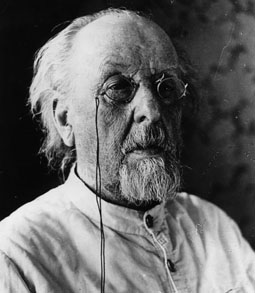| Konstantin E. Tsiolkovsky  AKA Konstantin Eduardovich Tsiolkovsky AKA Konstantin Eduardovich Tsiolkovsky
Born: 17-Sep-1857
Birthplace: Izhevskoye, Russia
Died: 19-Sep-1935
Location of death: Kaluga, Russia
Cause of death: unspecified
Remains: Buried, Park of the Cosmonauts Museum, Kaluga, Russia
Gender: Male
Race or Ethnicity: White
Sexual orientation: Straight
Occupation: Scientist Nationality: Russia
Executive summary: Astronautics and rocket dynamics pioneer Scientist, author, teacher, and visionary, Konstantin E. Tsiolkovsky was one of the founding fathers of rocketry and cosmonautics. His Tsiolkovsky formula, published in 1903, established the accurate relationships between the mass of the rocket and its propellant, the speed of the gas at exit, and rocket speed. He additionally predicted many aspects of space travel with stunning accuracy, describing many of the details of pressurized space suits, orbital space stations, the use of solar power, life in low gravity environments, and the need for multistage rockets to achieve escape velocity. He even predicted the advantages of combining liquid hydrogen and liquid oxygen for rocket fuel. Although two other scientists, Robert Goddard and Hermann Oberth, derived many of his basic principles around the same time (independently), it was the work of Tsiolkovsky that would later be given credit for inspiring and informing the fledgling Soviet space program that beat the U.S. into space.
Born in 1857 in Izhevskoye, Russia, Tsiolkovsky was one of 18 children born to a Polish deportee/Siberian exile. From the age of ten he struggled with a severe hearing loss that made formal education difficult. At age fourteen he was expelled from school, but his hunger to learn led him to study books on his own. When he was sixteen his family, impressed by his progress, sent him to Moscow to educate himself at the renowned Chertkovskaya Library. In Moscow he was influenced by the science fiction of Jules Verne and the theories of friend and philosopher Nikolai Fedorov (who convinced him that advances in science would create a subsequent population explosion that would require colonization of other planets). Finally, in 1879 Tsiolkovsky qualified to become a teacher and was able to support himself while writing stories of space travel and (later) while generating his scientific theories. In 1911 he published Investigations of Outer Space by Rocket Devices, and in 1914 Aims of Astronauts.
In 1917, after the Bolshevik revolution led to the creation of the Soviet Union, his work received formal recognition and in 1921 he was awarded a lifetime pension from the state. He retired from teaching to devote himself wholly to his space flight investigations. In 1935 he died at his home in Kaluga, Russia at the age of 78. Honors paid to him have included induction into the International Aerospace Hall of Fame, the naming of a lunar crater in his memory, and the creation of a museum (the Konstantin E. Tsiolkovsky State Museum of the History of Cosmonautics), devoted to his work. In Russia, Konstantin Tsiolkovsky is known as "the father of theoretical and applied cosmonautics."
Father: Eduard Ignatievich Tsiolkovsky (Polish forester)
Wife: Varvara E. Sokolova (m. Aug-1880)
Expelled from School
Asteroid Namesake 1590 Tsiolkovsky
Do you know something we don't?
Submit a correction or make a comment about this profile
Copyright ©2019 Soylent Communications
|